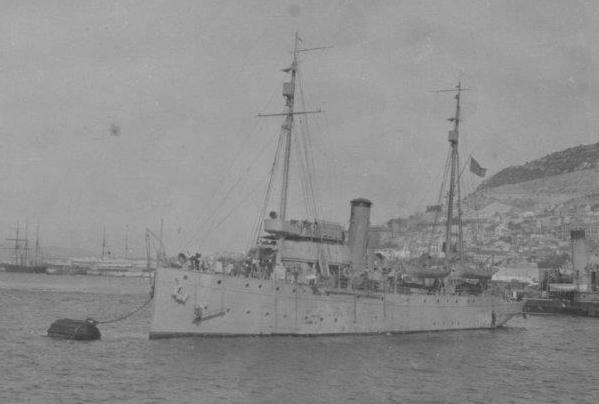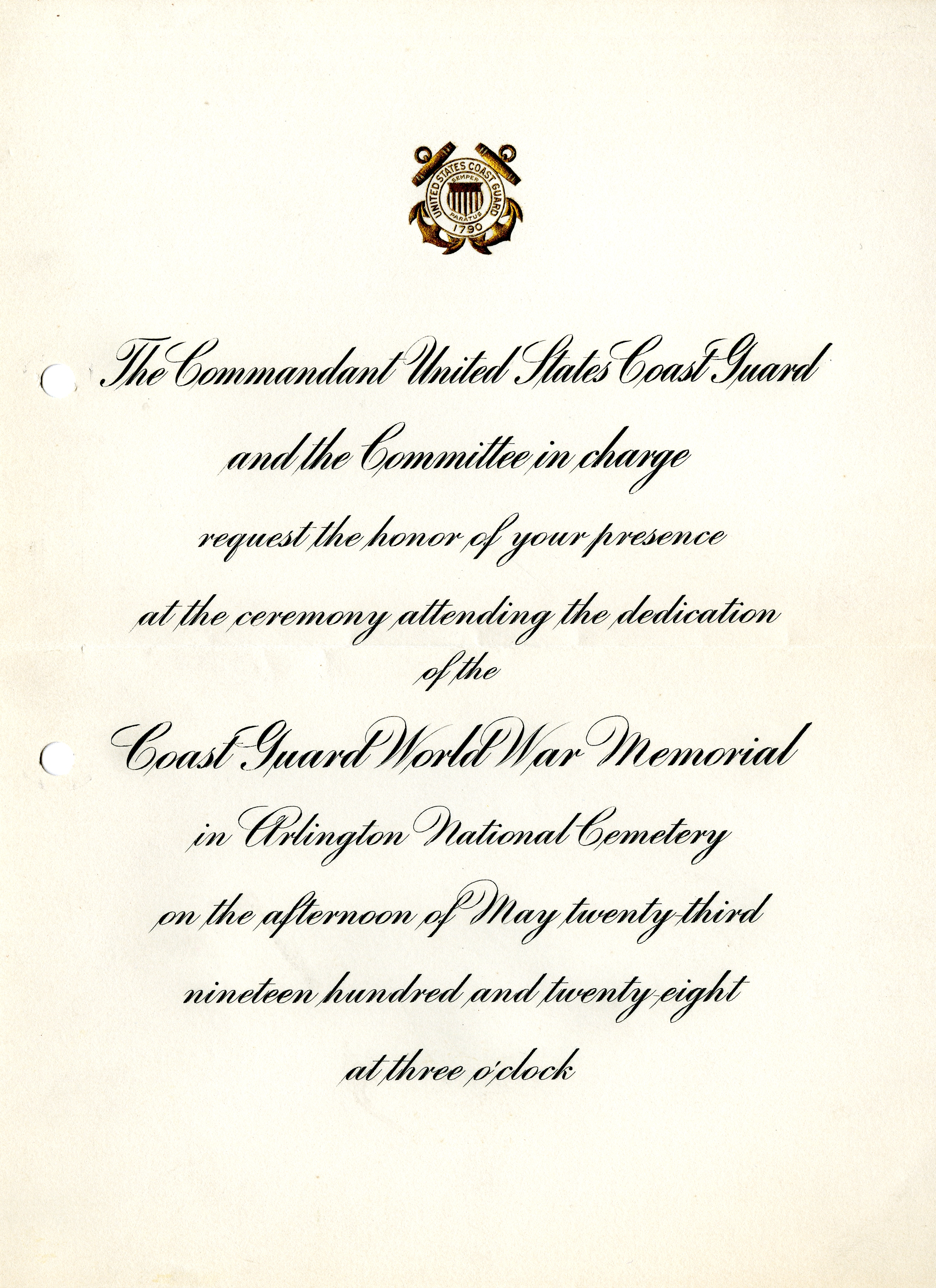Part 1.
As part of the United States Coast Guard’s (USCG) 230th birthday celebration, we are highlighting the history of the Coast Guard War Memorial at Arlington National Cemetery with a series of guest blog posts from the USCG. These posts tell the story of the Coast Guard War Memorial and its significant role in honoring and remembering the heroism and ultimate sacrifices made by Coast Guardsmen during the First World War.
On a pleasant spring day 92 years ago, Secretary of the Treasury Andrew Mellon stood up to address a gathering of 2000 people attending the May 23, 1928 dedication of the Coast Guard War Memorial at Arlington National Cemetery. Mellon offered these words: “We have come today to dedicate a memorial to the men of the Coast Guard who died in the World War. It is erected in gratitude to those who gave their lives for the country. In the hour of her great need, when danger threatened, and civilization itself seemed in the balance, these men laid down their lives in order that you and future generations might find the world a better place to live in.”
Secretary Mellon’s speech was among several high-profile and heartfelt tributes to the Coast Guard service members who had died in the line of duty during World War I. Family, friends and colleagues from near and far attended the dedication ceremony to pay homage to their lost loved ones and shipmates, and to share in a communal sense of grief and mutual support.
The Coast Guard War Memorial represented the culmination of many people’s time, effort and resources. For those individuals closely involved with the project, it was a personal labor of love and loyalty.
Two tragic naval losses during World War I generated the desire to create a memorial. The first incident involved the loss of eleven crewmen from the USS (CGC) Seneca during a harrowing rescue attempt to save the British steamer SS Wellington and its crew, after the latter was torpedoed off the coast of France on September 16, 1918. The heavily damaged Wellington sank in a storm on the evening of September 17, while being towed into port. The second naval loss involved the USS (CGC) Tampa, which was torpedoed by a German submarine on September 26, 1918 as it transited towards the Bristol Channel and the Allied port of Milford Haven in Wales. Tampa’s entire crew, and all passengers, went down with the cutter−a loss of 131 men.
Seneca and Tampa enjoyed a close bond in the years leading up to and during the war. Both served as the initial team of cutters assigned to International Ice Patrol duties from 1913 to 1916. The two cutters’ commanding officers, William Wheeler and Charles Satterlee, were best friends: their friendship went back twenty years to their cadet days on the training ship Chase, as students in the Revenue Cutter School of Instruction. During the war, the two men regularly spent time together in port when their convoy runs between England and Gibraltar overlapped. Because of their close ties, Tampa’s sinking was a devastating personal blow to Wheeler. Considering it his sacred duty, and trying to come to terms with this loss, Wheeler spent the greater part of the first postwar decade honoring the memory of his lost shipmate.

D.A. Stone, “Seneca/Wellington Rescue.” Coast Guard Art Collection.

Heritage Command, U.S. Navy.
With the catastrophic and total loss of Tampa, and crew losses from Seneca also fresh on everyone’s minds, the idea to establish a Coast Guard memorial had its inception soon after the signing of the Armistice on November 11, 1918. By March 1925, the Coast Guard formed an eleven-person advisory committee to oversee the planning of the memorial. Rear Admiral Frederick Billard, then Coast Guard Commandant, served as the committee’s honorary chairman, and Commander William Wheeler was appointed chairman. Other members of the committee had close associations with the cutters or their lost crew members.
From March 1925 to May 1928, the advisory committee developed and directed the memorial project. They promoted the memorial, solicited funds, selected a design, obtained a third of an acre at Arlington National Cemetery from the War Department, and planned and carried out the dedication ceremony. It was a daunting and solemn undertaking.
Two main fundraising drives aimed to raise a minimum of $35,000. The first general solicitation went out in 1925 to Coast Guard service members and additional supporters, such as the League of Coast Guard Women and veterans. It was suggested that each member of the Coast Guard, active duty and retired, donate one day’s worth of pay. Yet this effort netted only $14,000 by mid-March 1927. With $21,000 left to raise, the advisory committee stepped up its appeals to all commissioned and warrant officers, active duty and retired. The committee reminded officers to consider the Coast Guard’s proud history and accomplishments. In addition, officers were encouraged to sponsor monthly fundraising drives at their individual units, ashore and afloat. Pledge quotas were established for 132 Coast Guard units. This strategy paid off. One month later, by April 27, 1927, an additional $3,238 had been collected from a variety of sources, including commissioned and warrant officers, 27 of the 132 Coast Guard units and maritime-related businesses. Hoping to set an example for others, high-ranking officials from the Treasury Department, including Secretary Andrew Mellon himself, personally contributed generous amounts of money.
Concurrent with ongoing fundraising efforts, in late 1925 the federal Commission of Fine Arts selected Philadelphia-based architectural firm Mellor, Meigs & Howe to design the monument and surrounding area. The firm worked closely with the advisory committee, and by December 1926, the Commission approved designs for both the memorial and the surrounding landscape plan. According to the advisory committee, “the Memorial will be both symbolical and historical, consisting of a (12 ft. high) pyramid of marble with a granite base, and a thirty four foot circle of paving set on a granite foundation.” Evergreen trees and shrubbery would be planted to form the background, and a bronze seagull, made by noted sculptor Gaston Lachaise, would be placed at the front of the pyramid as a graceful symbol of the sea. Chiseled above the seagull is the emblem of the Coast Guard, along with its motto, “Semper Paratus” (“Always Ready”). Directly below that are the words, “United States Coast Guard.” The names of those men who made the supreme sacrifice, and those who died in the course of war duties, would be inscribed on the sides of the memorial.
After the Commission of Fine Arts granted its approval, construction began in 1927, with contractor J.F. Manning Co. of Washington, D.C. conducting the work. Fundraising and construction continued through 1927 and into the early months of 1928. Although the memorial’s final completion date is not known at this time, on March 3, 1928, the Commission of Fine Arts reported its satisfaction with construction progress. Advisory committee members set Wednesday, May 23, 1928 as the date for the memorial’s dedication.
Elaborate plans were drawn up for the dedication ceremony. For the day of the dedication, four cutters̶ − Tampa, Seneca, Manning and Apache − were ordered to arrive and to stand watch at the Washington Navy Yard. A military force consisting of the corps of cadets (under arms), a stand of colors, and a provisional Coast Guard enlisted battalion would parade at Arlington. Engraved invitations went out and tickets were issued for reserved seating. Attendees consisted of local and national dignitaries, government officials, Coast Guard personnel and, importantly, 20 family members of the men whose names were inscribed on the memorial. Of the family members who attended, most represented those lost on the Tampa. A smaller contingent of family members came in support of the Seneca and the additional 75 men who lost their lives in the line of duty during the war, whose names were also inscribed on the side of the memorial. The family members’ presence offered a potent reminder of war’s human toll on the Coast Guard community and reflected their shared grief, sacrifice and patriotism.


United States Coast Guard Archival Collection.
On May 23, 1928, the Coast Guard War Memorial dedication ceremony began at three o’clock sharp. The order of exercises incorporated a military parade; opening and closing prayers; addresses by Secretary of the Treasury Andrew Mellon, Secretary of the Navy Curtis Wilbur and Coast Guard Commandant Frederick Billard; and a musical ensemble that featured Coast Guard march “Semper Paratus, My Country ‘Tis of Thee” and a classical piece by Beethoven. A presentation of floral tributes accompanied the memorial’s unveiling. Somber and patriotic, the ceremony concluded with “Taps” and the military march “All Hands” by Charles Benter.
Today, on the 230th birthday of the United States Coast Guard, the Coast Guard War Memorial at Arlington National Cemetery stands as a solemn reminder of the service and sacrifices rendered by the Coast Guard. It remains as a testament of the Coast Guard’s dedication both to their duty to the nation and to commemorating their fallen.